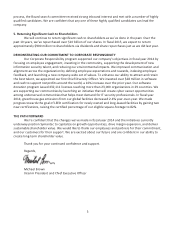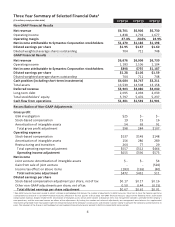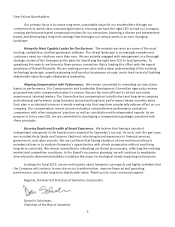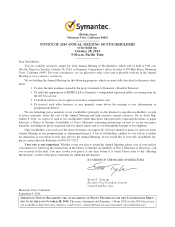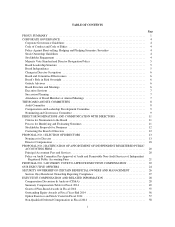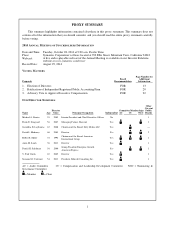Symantec 2014 Annual Report Download - page 15
Download and view the complete annual report
Please find page 15 of the 2014 Symantec annual report below. You can navigate through the pages in the report by either clicking on the pages listed below, or by using the keyword search tool below to find specific information within the annual report.Majority Vote Standard and Director Resignation Policy
Our Bylaws and Corporate Governance Guidelines provide for a majority voting standard for the election of
directors. Under the majority vote standard, each nominee must be elected by a majority of the votes cast by the
shares present in person or represented by proxy and entitled to vote at any meeting for the election of directors
at which a quorum is present. A “majority of the votes cast” means the votes cast “for” a nominee’s election must
exceed the votes cast “against” that nominee’s election. A plurality voting standard will apply instead of the
majority voting standard if: (i) a stockholder has provided us with notice of a nominee for director in accordance
with our Bylaws; and (ii) that nomination has not been withdrawn as of 10 days before we first deliver proxy
materials to stockholders.
To effectuate this policy with regard to incumbent directors, the Board will not nominate an incumbent direc-
tor for re-election unless prior to such nomination the director has agreed to promptly tender a resignation if such
director fails to receive a sufficient number of votes for re-election at the stockholder meeting with respect to
which such nomination is made. Such resignation will be effective upon the earlier of (i) the Board’s acceptance
of such resignation or (ii) the 90th day after certification of the election results of the meeting; provided, how-
ever, that prior to the effectiveness of such resignation, the Board may reject such resignation and permit the
director to withdraw such resignation.
If an incumbent director fails to receive the required vote for re-election, the Nominating and Governance
Committee shall act on an expedited basis to determine whether to recommend acceptance or rejection of the
director’s resignation and will submit such recommendation for prompt consideration by the Board. The Board
intends to act promptly on the Committee’s recommendation and will decide to accept or reject such resignation
and publicly disclose its decision within 90 days from the date of certification of the election results. The Nomi-
nating and Governance Committee and the Board may consider such factors they deem relevant in deciding
whether to accept or reject a resignation tendered in accordance with this policy. The Board expects a director
whose resignation is under consideration to abstain from participating in any decision regarding the resignation.
Board Leadership Structure
Our Board does not have a policy on whether the roles of Chief Executive Officer and Chairman should be
separate. Instead, it retains the flexibility to determine on a case-by-case basis whether the Chief Executive Offi-
cer, or an independent director, should serve as Chairman. During those periods in which the positions of Chair-
man and Chief Executive Officer are combined, the independent directors appoint an independent director as a
Lead Independent Director. Currently, the roles of Chief Executive Officer and Chairman are separate. Daniel
Schulman, one of our independent directors, was appointed as non-executive Chairman of the Board in January
2013. The Board believes that having an independent director serve as the non-executive Chairman of the Board
is the appropriate leadership structure for our company at this time because it allows our Chief Executive Officer
to focus on executing our company’s strategic plan and managing our company’s operations and performance,
while allowing the Chairman of the Board to focus on the effectiveness of the Board and independent oversight
of our senior management team.
Board Independence
It is the policy of the Board and NASDAQ’s rules require that listed companies have a board of directors
with at least a majority of independent directors, as defined under NASDAQ’s Marketplace Rules. Currently,
each member of our Board, other than our interim President and Chief Executive Officer, Michael A. Brown, is
an independent director and all standing committees of the Board are composed entirely of independent directors,
in each case under NASDAQ’s independence definition. The NASDAQ independence definition includes a series
of objective tests, such as that the director is not an employee of the company and has not engaged in various
types of business dealings with the company. In addition, the Board has made a subjective determination as to
each independent director that no relationship exists which, in the opinion of the Board, would interfere with the
exercise of independent judgment in carrying out the responsibilities of a director. In making these determi-
nations, the directors reviewed and discussed information provided by the directors and our company with regard
to each director’s business and other activities as they may relate to Symantec and our management. Based on
5


